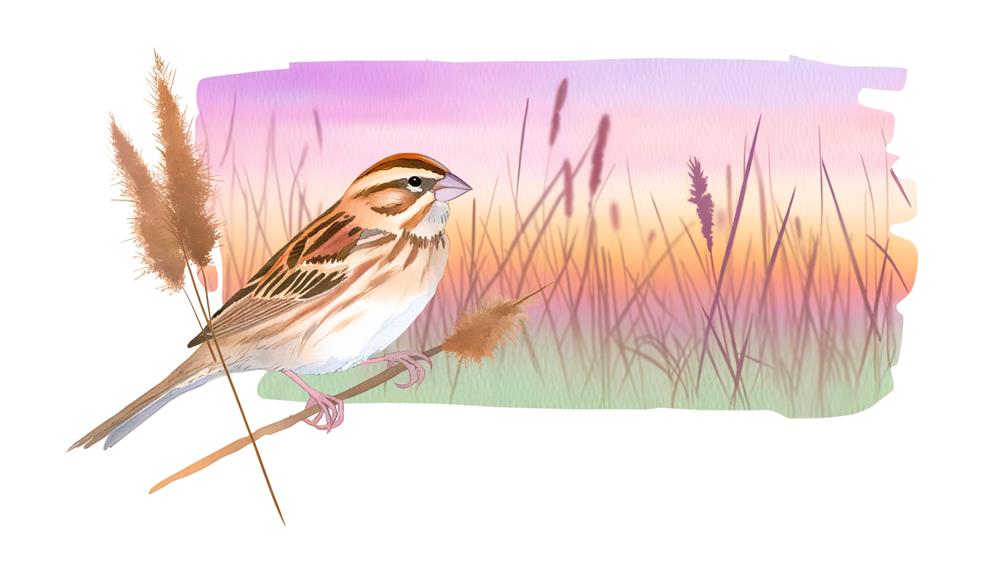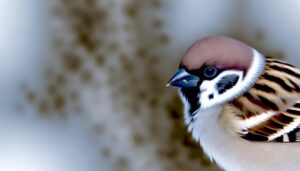How to Identify the Field Sparrow by Its Scientific Name
The Field Sparrow's answer for a scientific name is Spizella pusilla. This title adheres to the systematic naming method of binomial nomenclature, introduced by Carolus Linnaeus.
The name includes a genus name, Spizella, and a species epithet, pusilla. It speaks volumes about the bird's small size, specific vocalizations, and preferred habitats.
Surprisingly, these names are unique and universally recognized, assisting in eliminating ambiguity in species identification and classification. Anyone keen on knowing more about the fascinating adaptability, traits, distribution, and importance of Field Sparrows in conservation will find the following information intriguing.

Key Takeaways
- The scientific name of the Field Sparrow is Spizella pusilla.
- This name is part of the binomial nomenclature system, introduced by Carolus Linnaeus.
- The genus name, Spizella, reflects the bird's small size and distinctive vocalizations.
- Understanding the Field Sparrow's scientific name aids in correctly identifying and classifying it within its genus.
- Accurate use of scientific names is crucial for conservation efforts, ensuring precise species identification.
Understanding Bird Classification
While it may seem complex at first glance, bird classification actually follows a logical structure that helps scientists categorize and understand the vast diversity in the avian world. This system, known as taxonomy, is based on shared physical and genetic traits, allowing for accurate identification and study of species.
Birds are first divided into classes, then orders, families, genera, and finally species. The Field Sparrow, for example, falls in the class Aves, order Passeriformes, family Emberizidae, genus Spizella, and species pusilla. This detailed classification reflects the bird's evolutionary history, ecological role, and anatomical characteristics.
It's not just labels; it's a way of decoding a bird's place in the grand scheme of nature.
Basics of Scientific Nomenclature
Exploring the world of scientific nomenclature, understanding that this systematic method of naming organisms plays a pivotal role in the precise identification and classification of species is crucial.
This language, universally adopted by the scientific community, is meticulously structured, ensuring clarity and eliminating ambiguity. Each name is unique to a species, serving as a global identifier.
It's built on a hierarchy, starting with the broadest category (kingdom) and narrowing down to the most specific (species). The nomenclature covers all life forms, from bacteria to plants, animals, and fungi.
It uses Latin or Latinised names, facilitating communication among scientists worldwide. Essentially, scientific nomenclature is a codified system that enables efficient, clear, and accurate communication about the vast diversity of life on Earth.
Role of Binomial Nomenclature
Delving into the heart of scientific nomenclature, we find binomial nomenclature playing a pivotal role in providing each species with a unique, universally recognized name. Originated by Carolus Linnaeus, this system employs a two-part name: a generic name (genus) and a specific epithet (species).
The table below illustrates the elements of binomial nomenclature:
| Element | Description | Example |
|---|---|---|
| Genus | Broad classification; always capitalized | Spizella |
| Species | More specific classification; never capitalized unless a proper noun | pusilla |
| Combined Name | The full binomial name of the species | Spizella pusilla |
Through this method, organisms are systematically categorized, drastically reducing confusion and miscommunication in the scientific community. The binomial nomenclature serves as the backbone of taxonomy and the universal language of biology, highlighting its integral importance in scientific study.
Decoding the Field Sparrow's Name
Deciphering the Field Sparrow's scientific name involves a comprehension of the principles of scientific nomenclature, particularly the usage of Latin names.
The Latin name of the Field Sparrow, Spizella pusilla, offers significant insights into the bird's characteristics and taxonomy.
Analysis of species' names not only provides an understanding of an organism's attributes, but also its evolutionary relationships and ecological roles.
Understanding Scientific Nomenclature
To truly appreciate the Field Sparrow's scientific name, Spizella pusilla, it's essential to explore the nuances of scientific nomenclature, a system that allows a precise and universal identification of species.
This globally recognized system is based on binomial nomenclature, introduced by Carl Linnaeus in the 18th century, which utilizes Latin or Latinized names. Each species name is a combination of the genus and specific epithet, providing a unique, standardized identity.
Spizella, the genus, indicates the sparrow's relation to like species, while pusilla, the specific epithet, offers further differentiation. It's a meticulous process, one that guarantees no two species share the same name, providing critical clarity in the vast world of biological taxonomy.
Field Sparrow's Latin Name
Now, let's unravel the Latin name of the Field Sparrow, Spizella pusilla, to better understand its meaning and significance in biological classification.
Spizella, its genus, is a derivative of the Greek word 'spiza,' meaning finch. This suggests a similarity in size or behavior to finches.
The species epithet, pusilla, translates to small or tiny in Latin, accurately depicting the bird's petite stature.
Together, they construct a scientific descriptor that encapsulates the essence of the Field Sparrow: a small bird akin to a finch.
This nomenclature, while concise, offers a wealth of information, aiding in the identification and classification of the bird.
This parsing of the Field Sparrow's Latin name illustrates the precision inherent in scientific naming.
Significance of Species' Names
Understanding the significance of the Field Sparrow's scientific name, Spizella pusilla, illuminates not only the bird's physical characteristics but also its place in the broader avian taxonomy.
- 'Spizella' is Latin for 'little finch' revealing its small size and close relation to finches.
- 'Pusilla' translates to 'very small,' reinforcing its diminutive stature.
- By placing this bird within the Spizella genus, taxonomists highlight its shared traits with other finches.
- The specific epithet 'pusilla' further narrows its position, indicating its status as one of the smallest members within the genus.
This decoding process reveals how scientific names serve as a shorthand, encapsulating key information about a species' physical attributes and evolutionary relationships.
Field Sparrow: Genus Exploration
The Field Sparrow, scientifically recognized as Spizella Pusilla, belongs to a genus characterized by intriguing traits and adaptations.
Features inherent to this genus manifest themselves distinctively across varied habitats, with the Field Sparrow being no exception.
An examination of these characteristics and habitat adaptations, particularly in relation to the Field Sparrow, provides fascinating insights into the broader Spizella genus.
Field Sparrow: Spizella Pusilla
Spizella Pusilla, better known as the Field Sparrow, stakes its claim as a small songbird in the American sparrow family, exhibiting remarkable features and behaviors inherent to its genus.
This genus, Spizella, is known for its remarkable adaptability, comprising species that thrive in diverse habitats.
Specifically, the Field Sparrow showcases these key characteristics:
- Size: Spizella Pusilla is a modestly sized bird, typically measuring 12-15 cm long.
- Color: The Field Sparrow's plumage varies from reddish-brown to gray, often with a distinctive pink bill.
- Habitat: It prefers open woodland and bushy pastures, showcasing the genus' versatility.
- Song: Its clear, melodious song sets it apart, reflecting the genus' reputation for vocal complexity.
Sparrow Genus Characteristics
Delving into the genus Spizella, we find a group of sparrows known for their adaptability and diverse range of habitats, with the Field Sparrow serving as a prime example. This genus, indeed, is defined by certain characteristics that set them apart. These include their small size, distinctive vocalizations, and a preference for open habitats, including grasslands and shrublands.
To provide a clearer understanding, let's explore the following characteristics:
| Characteristic | Description |
|---|---|
| Size | Spizella sparrows are relatively small, most species measuring between 12-15cm in length |
| Vocalizations | Their songs are distinctive, often consisting of a series of high-pitched notes |
| Habitat Preference | They generally favor open habitats, specifically grasslands and shrublands |
| Adaptability | Despite their preference, they are known for their ability to adapt to varied environments |
The Field Sparrow, in particular, embodies these characteristics, making it an exemplar of the Spizella genus.
Field Sparrow Habitat Adaptations
In analyzing how the Field Sparrow adapts to its habitat, it's important to understand that this bird's adaptability is largely influenced by its inherent characteristics, such as its small size and distinctive vocalizations, which allow it to thrive in diverse environments. The Field Sparrow's adaptability is seen in:
- Its small size, allowing it to occupy tiny crevices and holes for shelter.
- Its varied diet, comprising seeds, insects, and small fruits, which are found in abundance in its habitat.
- The bird's unique vocalizations, used to claim territory and attract mates.
- Its migratory nature, which aids in the survival of harsh winters by moving to warmer environments.
These traits contribute to the Field Sparrow's resilience, enabling it to adapt and flourish in various habitats.
Detailed Species Analysis
While examining the field sparrow, it's evident that this species, scientifically known as Spizella pusilla, exhibits a fascinating complexity in its behavior, morphology, and ecological role.
Behaviorally, these birds are primarily insectivorous during the summer, switching to seeds in colder months.
Morphologically, they're distinct, with clear, pink beaks and warm brown upperparts. A white eye-ring adds to their unique appearance.
Ecologically, they play an essential role in controlling insect populations and aiding in seed dispersal.
Their songs, used in territory defense and attracting mates, contribute to nature's symphony. They're also a crucial link in the food chain, providing sustenance for predators.
Field Sparrow Distribution and Habitat
Field sparrows, or Spizella pusilla, inhabit a diverse range of habitats across North America, exhibiting a preference for brushy, shrub-dominated landscapes and abandoned agricultural fields.
Their distribution and habitat preferences can be classified into four key areas:
- Eastern and Central North America: Here, field sparrows are found in abundance due to the availability of shrublands and abandoned farmlands.
- Southern Canada: They migrate here during the breeding season, seeking out habitats with dense shrub cover.
- Mexico: In the winter, field sparrows migrate to Mexico where they occupy overgrown fields and scrubby areas.
- Urban and Suburban Areas: Surprisingly, they're also found in urban parks and gardens with sufficient vegetation cover.
This distribution pattern points to the adaptability and resilience of this species in diverse habitats.
Fascinating Field Sparrow Facts
Boasting a melodious song that stands out even amid the cacophony of a bustling forest, the field sparrow presents a fascinating study in avian behavior and adaptability.
Unlike most songbirds, this species has a unique characteristic – it can modify its tune. This acoustical flexibility allows it to adjust its song according to its environment, ensuring effective communication.
Additionally, field sparrows exhibit an intriguing feeding behavior known as 'double-scratching.' They'll rapidly hop forward and backward, scratching the earth with both feet to uncover hidden food.
Despite their diminutive size, they can consume up to a third of their body weight daily. Their diet consists primarily of seeds in winter and insects in summer, demonstrating a seasonal dietary adaptability.
Importance of Scientific Names in Conservation
Understanding the scientific names of species like the field sparrow, officially known as Spizella pusilla, is important in conservation efforts, as it guarantees precise identification and effective communication among scientists worldwide.
The primary benefits of using scientific names in conservation include:
- Accurate Identification: It ensures each species is distinctly recognized, eliminating the possibility of confusion with common names, which vary by region.
- Effective Communication: By using a universally accepted language, scientists from different parts of the world can seamlessly collaborate on conservation initiatives.
- Conservation Prioritization: Knowing the exact species helps in prioritizing which ones are most at risk and need immediate attention.
- Historical Tracking: Scientific names reflect evolutionary relationships, providing a broader context for conservation strategies.
Conclusion
Essentially, the Field Sparrow, scientifically known as Spizella pusilla, is a fascinating bird with its own unique characteristics. With a population estimated at 14 million, it's prevalent in North America.
Understanding its scientific classification isn't just a linguistic exercise, but a significant part of conserving its species. This knowledge shapes our ability to monitor, conserve, and appreciate the biodiversity that surrounds us.
So, let's continue to explore and appreciate our feathered friends.






